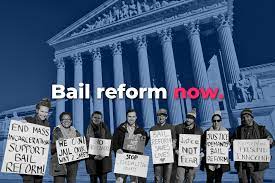Introduction
Bail reform in the United States has emerged as a pivotal issue within the broader context of criminal justice reform, driven by growing concerns over equity, fairness, and the effectiveness of the pretrial system. At the heart of the debate is the recognition that the traditional cash bail system disproportionately affects low-income individuals, perpetuating a cycle of poverty and incarceration that undermines the principle of equality before the law. This essay explores the origins of the bail reform movement, the challenges it seeks to address, the various models of reform proposed and implemented across different jurisdictions, and the impacts these reforms have had on communities and the criminal justice system.
Origins of the Bail Reform Movement
The movement for bail reform in the USA finds its roots in the recognition that the cash bail system often results in pretrial detention for individuals who are unable to afford bail, regardless of their guilt or innocence. This practice has been criticized for its disproportionate impact on minority and low-income communities, contributing to systemic inequalities within the criminal justice system. The seminal 1966 Bail Reform Act, which applied to federal crimes, marked an early legislative effort to address these issues, emphasizing the release of defendants on their own recognizance unless deemed a flight risk or a threat to the community.
Challenges Addressed by Bail Reform
The primary challenge bail reform seeks to address is the inequity of the cash bail system, where wealth, rather than risk, determines an individual’s ability to secure pretrial release. Critics argue that this system:
- Unfairly penalizes the poor, leading to job loss, housing instability, and other social detriments.
- Contributes to overcrowded jails, with a significant proportion of the incarcerated population held awaiting trial.
- Does not effectively enhance public safety, as many detained are low-risk, non-violent offenders.
- Encourages plea bargains, often resulting in convictions and criminal records for individuals who might be acquitted if they were able to fight their cases from a position of freedom.
Models of Bail Reform
Bail reform initiatives across the United States have varied widely, with some jurisdictions eliminating cash bail altogether and others implementing risk assessment tools to guide pretrial release decisions. Key models include:
Risk Assessment Instruments:
Utilizing data-driven tools to evaluate the risk a defendant poses in terms of fleeing or committing new crimes if released pretrial.
Pretrial Services Programs:
Offering supervision or monitoring, akin to probation, designed to support defendants in meeting court dates and conditions of release.
Legislative Reforms:
Some states have passed laws to restrict the use of cash bail, particularly for minor offenses, and encourage non-monetary conditions for release.
Abolition of Cash Bail:
A few jurisdictions, notably New Jersey, have largely moved away from cash bail, relying on risk assessments and pretrial monitoring to manage defendants awaiting trial.
Impacts of Bail Reform
The impacts of bail reform are multifaceted and subject to ongoing debate:
Reduction in Jail Populations:
Many areas implementing bail reform have seen significant reductions in their pretrial incarcerated populations, alleviating jail overcrowding and reducing public spending on incarceration.
Community Stability:
Individuals released pretrial are more likely to maintain employment, housing, and family connections, contributing to community stability and resilience.
Public Safety Concerns:
Some critics argue that bail reform may pose risks to public safety by allowing potentially dangerous individuals to be released. However, evidence from jurisdictions that have implemented reform suggests that public safety has not been compromised, and in some cases, has been enhanced by focusing resources on high-risk defendants.
Economic and Social Justice:
By addressing the disproportionate impact of the cash bail system on low-income individuals and communities of color, bail reform initiatives contribute to broader goals of economic and social justice.
As bail reform initiatives continue to evolve across the United States, it’s essential to delve deeper into the nuances of these reforms, including the debate surrounding their implementation, the role of technology and data in shaping future directions, and the broader implications for criminal justice reform. This extended discussion seeks to further illuminate these aspects and their contribution to reshaping pretrial detention practices in pursuit of a more just system.
The Debate on Implementation and Effectiveness
The implementation of bail reform has sparked a complex debate among policymakers, law enforcement officials, civil rights advocates, and the public. Proponents argue that reform is necessary to dismantle systemic inequities and reduce the unnecessary detention of nonviolent offenders. Critics, however, express concerns about the potential for increased flight risk and the challenge of accurately assessing the threat to public safety posed by individuals released pretrial. This debate underscores the need for a balanced approach that safeguards community safety while addressing the injustices of the cash bail system.
The Role of Technology and Data
Emerging technologies and the increasing availability of data are playing a pivotal role in shaping the future of bail reform. Risk assessment tools, which use algorithms to evaluate the likelihood of a defendant fleeing or committing new crimes, are at the forefront of this technological shift. While these tools offer the promise of more objective decision-making, they also raise concerns about transparency, bias, and the potential for reinforcing existing disparities. As such, there’s a growing call for rigorous evaluation and oversight of these technologies to ensure they serve as fair and effective instruments of reform.
Broader Implications for Criminal Justice Reform
Bail reform is part of a larger mosaic of criminal justice reform efforts aimed at addressing systemic issues such as mass incarceration, racial disparities, and the criminalization of poverty. By challenging the traditional reliance on cash bail, these reforms question fundamental aspects of the justice system’s approach to pretrial detention. They also highlight the need for comprehensive strategies that include improved access to legal representation, investment in community-based alternatives to detention, and reforms in sentencing practices.
Future Directions and Challenges
As bail reform progresses, several key challenges and directions for future efforts emerge:
Ensuring Equity:
Continued vigilance is required to ensure that reforms do not inadvertently introduce new forms of inequity or bias, particularly through the use of automated risk assessment tools.
Community-Based Alternatives:
Expanding and investing in alternatives to detention, such as electronic monitoring, community supervision, and support services, can help address the root causes of criminal behavior and reduce recidivism.
Legislative and Policy Changes:
Ongoing legislative efforts at both state and federal levels are crucial to codifying reforms and ensuring that they have the necessary legal backing to be sustainable and effective.
Public Engagement and Education:
Engaging communities in dialogue about bail reform and its implications for public safety and justice is essential to building broad-based support and addressing concerns and misconceptions.
 Conclusion
Conclusion
Bail reform in the United States represents a critical step toward creating a more equitable, effective, and humane criminal justice system. While challenges remain, particularly in balancing the goals of public safety and justice reform, the movement has already demonstrated significant potential for positive change. As reforms continue to be debated, implemented, and refined, ongoing evaluation and adaptation will be essential to ensure that the nation’s pretrial practices uphold the principles of justice, equity, and community well-being.





